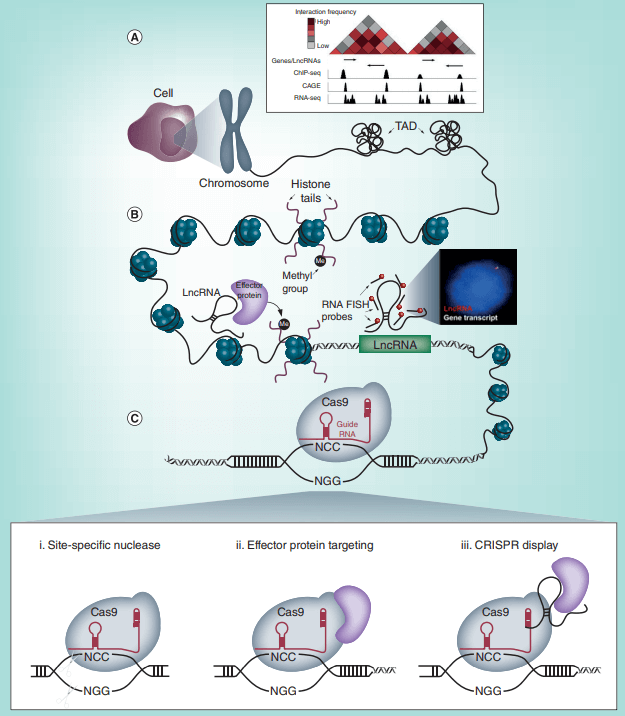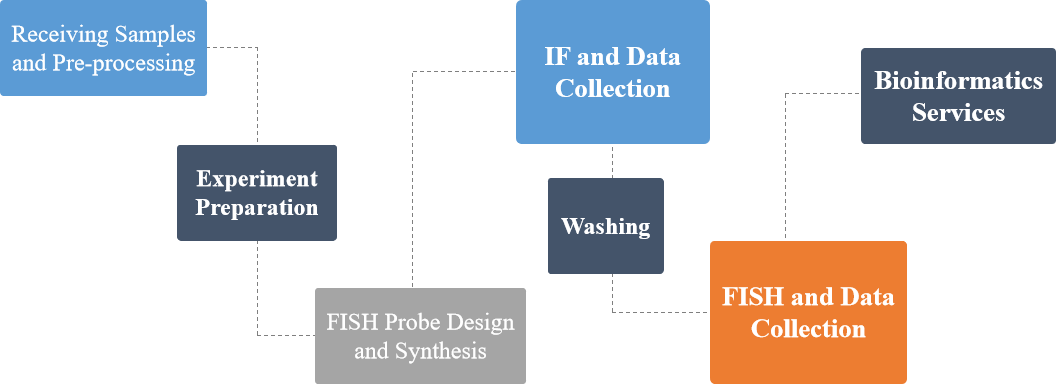Immuno-FISH Service
In situ immunofluorescence hybridization (immuno-FISH) is a reliable double staining method for RNA and cellular proteins, which is used to detect the localization and abundance of target RNA expression at the histological level. In situ hybridization (ISH) is a useful tool for quantifying and localizing specific RNA in cultured cells or tissue sections. Oligonucleotide probes are used to detect target RNA through complementary base pairing, and when combined with other techniques, the utility of FISH will increase. For example, immuno-FISH technology is a combination of FISH and immunohistochemical methods, which can detect RNA and protein in the same sample. Long non-coding RNAs (lncRNAs) are involved in a variety of biological processes. Compared with the extensive genome annotation of lncRNAs transcripts, the characteristics of subcellular localization and cell-to-cell variability are much less. The lncRNAs that have been identified in the past decade are associated with many physiological processes and various diseases. Studying the organization and subcellular localization of lncRNAs to determine their functions and potential mechanisms has unlimited potential.
 Fig 1. An overview of the pipeline and tools used to study lncRNA biology. (Fok E T, et al. 2017)
Fig 1. An overview of the pipeline and tools used to study lncRNA biology. (Fok E T, et al. 2017)
Immuno-FISH
Immuno-FISH is widely used to jointly detect RNA and protein to study their spatial distribution in cells. We are based on FISH-based RNA and DNA detection combined with protein/histone modification immunostaining methods, and provide analysis services for the analysis of lncRNA and epigenetic effects. Our immuno-FISH service is a comprehensive service, including single-molecule RNA FISH analysis services, immunofluorescence testing and bioinformatics services.
 Fig 2. Brief process of immuno-FISH service.
Fig 2. Brief process of immuno-FISH service.
Services
Our lncRNA FISH service is a comprehensive service. Based on smFISH technology, transcripts and end products can be analyzed at the same time. Our platform allows visualization and quantification of individual RNA transcripts and can achieve co-analysis of target lncRNA and mRNA. Our service process includes sample reception and pretreatment, FISH probe design and synthesis, hybridization and washing, microscopy service, and bioinformatics service.

| 
| 
| 
| 
|
| We can accept cultured fresh or fixed cell and tissue samples, and we can complete the subsequent permeabilization and antigen retrieval steps. | The probe design can be completed by our experts, or you can choose to submit your design proposal, and then we will synthesize oligonucleotide probes and fluorescently label the probes. | Then we will complete FISH hybridization and immunofluorescence staining in steps and harvest the microscope images. | Finally, our bioinformatics team will process the harvested data and give an analysis report. | Our agreement includes a series of quality control steps, which will be explained in the final experimental report. |
Creative Bioarray provides comprehensive immuno-FISH technical service options, realizing a one-stop laboratory service from sample pre-processing to generating publishable data. You will benefit from our technical expertise and laboratory service platform. Our team of experts will work with you to find the best solution for FISH analysis. If you are interested in our comprehensive analysis service of lncRNAs using smFISH and IF, please contact us for cooperation. We look forward to cooperating with you in the near future.
References
- Fok E T, Scholefield J, Fanucchi S, et al. The emerging molecular biology toolbox for the study of long noncoding RNA biology[J]. Epigenomics, 2017, 9(10): 1317-1327.
- Meng C, Zhao X, Lao J. A modified immunofluorescence in situ hybridization method to detect long non‑coding RNAs and proteins in frozen spinal cord sections[J]. Experimental and therapeutic medicine, 2018, 15(6): 4623-4628.
- Lanfranco M F, Loane D J, Mocchetti I, et al. Combination of fluorescent in situ hybridization (FISH) and immunofluorescence imaging for detection of cytokine expression in microglia/macrophage cells[J]. Bio-protocol, 2017, 7(22).
All products and services on this website are only suitable for non-medical purposes.


 Fig 1. An overview of the pipeline and tools used to study lncRNA biology. (Fok E T, et al. 2017)
Fig 1. An overview of the pipeline and tools used to study lncRNA biology. (Fok E T, et al. 2017) Fig 2. Brief process of immuno-FISH service.
Fig 2. Brief process of immuno-FISH service.







